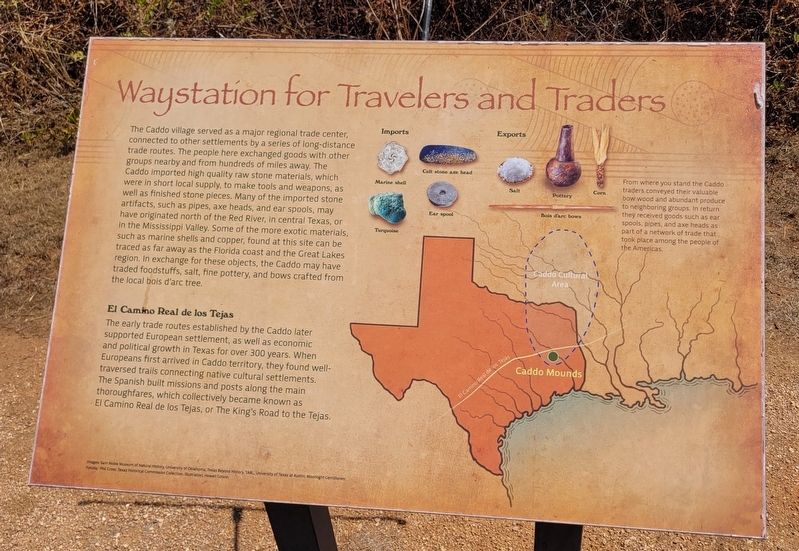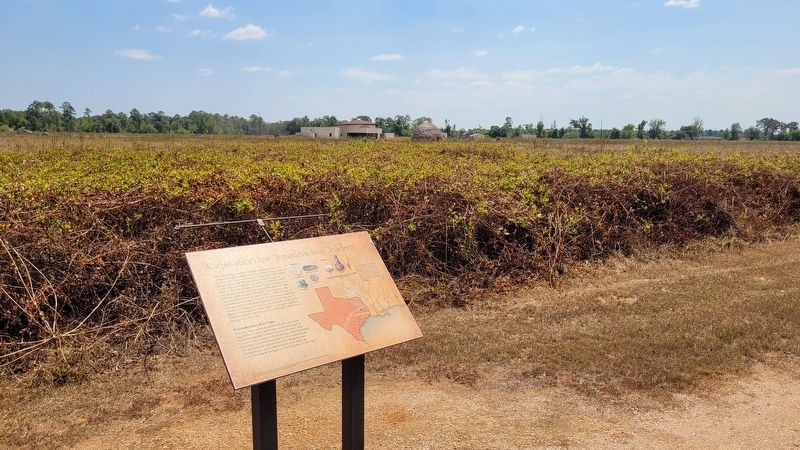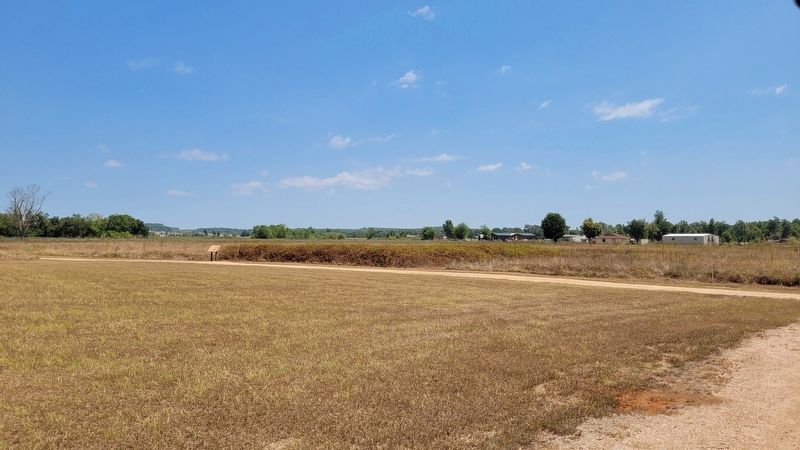Near Alto in Cherokee County, Texas — The American South (West South Central)
Waystation for Travelers and Traders
El Camino Real de los Tejas
The early trade routes established by the Caddo later supported European settlement, as well as economic and political growth in Texas for over 300 years. When Europeans first arrived in Caddo territory, they found well-traversed trails connecting native cultural settlements. The Spanish built missions and posts along the main thoroughfares, which collectively became known as El Camino Real de los Tejas, or The King's Road to the Tejas.
Captions
Imports
Marine shell • Turquoise • Celt stone axe head • Ear spool
Exports
Salt • Pottery • Corn • Bois d'arc bows
From where you stand the Caddo traders conveyed their valuable bow wood and abundant produce to neighboring groups. In return they received goods such as ear spools, pipes, and axe heads as part of a network of trade that. took place among the people of the Americas.
Images: Sam Noble Museum of Natural History, University of Oklahoma; Texas Beyond History TARL, University of Texas at Austin; Moonlight GemStones; Fatolla; Phi Cross; Texas Historical Commission Collection; Illustration, Howell Golson
Erected by Caddo Mounds State Historic Site.
Topics. This historical marker is listed in these topic lists: Anthropology & Archaeology • Native Americans.
Location. 31° 35.871′ N, 95° 9.054′ W. Marker is near Alto, Texas, in Cherokee County. Marker is at the intersection of State Highway 21 and Farm to Market Road 2907 on State Highway 21. The marker is located in the northern section of the Caddo Mounds State Historic Site. Touch for map. Marker is at or near this postal address: 1649 TX-21, Alto TX 75925, United States of America. Touch for directions.
Other nearby markers. At least 8 other markers are within walking distance of this marker. Burial Mound (within shouting distance of this marker); Zebulon Pike Campsite (about 400 feet away, measured in a direct line); El Camino Real de los Tejas (about 400 feet away); A Welcome Rest (about 500 feet away); Famous and Infamous Journeys (about 500 feet away); Travel Encounters (about 500 feet away); Natural Spring (about 600 feet away); Low Platform Mound (approx. 0.2 miles away). Touch for a list and map of all markers in Alto.
More about this marker. The marker is located in the Caddo Mounds State Historic Site and it does require a small entry fee to visit.
Also see . . . Caddo Mounds State Historic Site. Texas State Historical Association (TSHA)
Caddo Mounds State Historic Site, one of the best known and intensively investigated Indian sites in Texas, is on State Highway 21 about six miles southwest of Alto in southern Cherokee County. It comprises much of what is known to archeologists as the George C. Davis Site, the southwesternmost ceremonial center of the Caddoan peoples who flourished on the western edge of the woodlands of eastern North America between 1000 B.C. and A.D. 1550. Caddo Mounds consists of three large earthen mounds, as well as a large portion of a prehistoric village.(Submitted on September 8, 2023, by James Hulse of Medina, Texas.)
Credits. This page was last revised on September 9, 2023. It was originally submitted on September 8, 2023, by James Hulse of Medina, Texas. This page has been viewed 52 times since then and 10 times this year. Photos: 1, 2, 3. submitted on September 9, 2023, by James Hulse of Medina, Texas.


